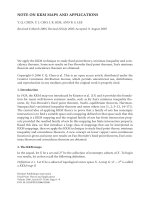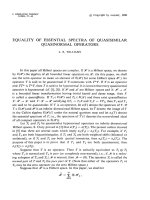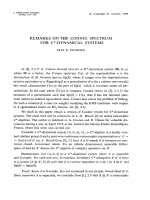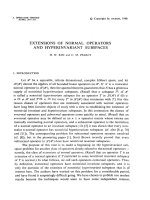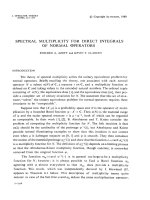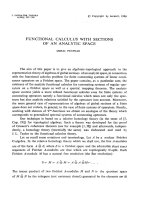Báo cáo toán học: "Tetrahedra on deformed spheres and integral group cohomology" pot
Bạn đang xem bản rút gọn của tài liệu. Xem và tải ngay bản đầy đủ của tài liệu tại đây (565.94 KB, 11 trang )
Tetrahedra on deformed spheres and
integral group cohomology
Pavle V. M. Blagojevi´c
∗
Mathematiˇcki Institut
Knez Michailova 35/1
11001 Beograd, Serbia
G¨unter M. Z iegler
∗∗
Inst. Mathematics, MA 6-2
TU Berlin
D-10623 Berlin, Germany
Submitted: Aug 28, 2008; Accepted: Jun 4, 2009; Published: Jun 10, 2009
Mathematics S ubject Classification: 55S91, 55M20, 52C99
Dedicated to Anders Bj¨orner on the occasion of his 60th birthday
Abstract
We show that for every injective continuous map f : S
2
→ R
3
there are four distinct
points in the image of f such that the convex hull is a tetrahedron with the property
that two opposite edges have the same length and the other four edges are also of
equal length. This result represents a partial result for the topological Borsuk
problem for R
3
. Our proof of the geometrical claim, via Fadell–Husseini index
theory, provides an instance where arguments b ased on group cohomology with
integer co efficients yield results that cannot be accessed us ing only field coefficients.
1 Introduction
The motivation for the study of the existence of particular types of tetrahedra on deformed
2-spheres is twofold. The topological Borsuk problem, as formulated by Soibelman in 1977
[6] (“estimate the minimal Borsuk partition number for the unit ball in R
n
for general
metrics!”), along with the square peg problem [5] first posed by Toeplitz 1911 (“does
every Jordan curve contain the vertices of a squa r e?”) inspire the search for possible
polytopes with nice metric properties whose vertices lie on the continuo us images of
spheres. Beyond their intrinsic interest, these problems can be used as testing grounds
for tools from equivariant topology, e.g. for comparing the strength of Fadell–Husseini
index theory with ring resp. field coefficients.
∗
Supported by the grant 144018 of the Serbian Ministry of Science and Technolo gical development
∗∗
Supported by the Germa n Resear ch Fo unda tion DFG
the electronic journal of combinatorics 16(2) (2009), #R16 1
The following theorem will be proved through the use of Fadell–Husseini index theory
with coefficients in the ring Z. It is also going to be demonstrated that Fadell–Husseini
index theory with coefficients in field F
2
has no power in this instance (Section 4.1).
Theorem 1.1. Let f : S
2
→ R
3
be an injective continuous map. Then its image contains
vertices of a tetrahedron that has at least the symmetry of a square. That is, there are
four distinct points ξ
1
, ξ
2
, ξ
3
and ξ
4
on S
2
such that
d(f(ξ
1
), f(ξ
2
)) = d(f (ξ
2
), f(ξ
3
)) = d(f (ξ
3
), f(ξ
4
)) = d(f (ξ
4
), f(ξ
1
))
and
d(f(ξ
1
), f(ξ
3
)) = d(f (ξ
2
), f(ξ
4
)).
Thus the tetrahedron may even be regular and thus have symmetry group S
4
; it may also
degenerate to a (planar) square.
Remark 1.2. The proof is not going t o use any properties of R
3
except that it is a metric
space. Thus in the statement of the theorem, R
3
can be replaced by any metric space
(M, d).
Figure 1: A D
8
-invariant tetrahedron on a deformed 2-sphere
Let us try to relate this to the square peg pro blem and the topological Borsuk problem:
The square peg problem is settled for various classes of sufficiently piecewise-smooth
Jordan curves, but open in general. Unfortunately, the methods used for the proof of
Theorem 1.1 do not imply any conclusion when applied to the square peg problem (see
Section 4.2). On the other hand, if the square peg problem could be solved for the
continuous Jordan curves, then it would imply the result of Theorem 1.1.
The first open instance of the topological Borsuk problem considers the existence of a
collection of four points with equal pairwise d-distances in a general metric space (R
3
, d).
The main result of the paper does not provide any new information concerning the topo-
logical Borsuk problem, as we work in the restricted parameter space {(x
1
, x
2
, x
3
, x
4
) ∈
(S
1
)
4
| x
1
= x
3
or x
2
= x
4
} whose dimension is much smaller compared to the one used
in the topological Borsuk problem {(x
1
, x
2
, x
3
, x
4
) ∈ (R
3
)
4
| x
1
= x
3
or x
2
= x
4
}.
the electronic journal of combinatorics 16(2) (2009), #R16 2
2 Introducing the equivariant que stion
Let f : S
2
→ R
3
be an injective continuous map. Denote by D
8
the symmetry group of a
square, that is, the 8-element dihedral g roup D
8
= ω, j | ω
4
= j
2
= 1, ωj = jω
3
.
A few D
8
-representations.
The real vector spaces
U
4
= {(x
1
, x
2
, x
3
, x
4
) ∈ R
4
| x
1
+ x
2
+ x
3
+ x
4
= 0},
U
2
= {(x
1
, x
2
) ∈ R
2
| x
1
+ x
2
= 0}
are real D
8
-representations with actions given by
(a) for (x
1
, x
2
, x
3
, x
4
) ∈ U
4
:
ω · (x
1
, x
2
, x
3
, x
4
) = (x
2
, x
3
, x
4
, x
1
), j · (x
1
, x
2
, x
3
, x
4
) = (x
3
, x
2
, x
1
, x
4
),
(b) for (x
1
, x
2
) ∈ U
2
:
ω · (x
1
, x
2
) = (x
2
, x
1
), j · (x
1
, x
2
) = (x
2
, x
1
),
The configuration space.
Let X = S
2
× S
2
× S
2
× S
2
and let Y be the subspace given by
Y =
(x, y, x, y) | x, y ∈ S
2
≈ S
2
× S
2
.
The configuration space to be considered is the space
Ω := X\Y.
Let a D
8
-action on X be induced by
ω · (ξ
1
, ξ
2
, ξ
3
, ξ
4
) = (ξ
2
, ξ
3
, ξ
4
, ξ
1
), j · (ξ
1
, ξ
2
, ξ
3
, ξ
4
) = (ξ
4
, ξ
3
, ξ
2
, ξ
1
),
for (ξ
1
, ξ
2
, ξ
3
, ξ
4
) ∈ X.
A test map.
Let τ : Ω → U
4
× U
2
be a map defined for (ξ
1
, ξ
2
, ξ
3
, ξ
4
) ∈ X by
τ(ξ
1
, ξ
2
, ξ
3
, ξ
4
) =
d
12
−
∆
4
, d
23
−
∆
4
, d
34
−
∆
4
, d
41
−
∆
4
×
d
13
−
Φ
2
, d
24
−
Φ
2
(1)
where d
ij
= d
ji
:= d(f (ξ
i
) , f (ξ
j
)) and
∆ = d
12
+ d
23
+ d
34
+ d
14
, Φ = d
13
+ d
24
.
the electronic journal of combinatorics 16(2) (2009), #R16 3
With the D
8
-actions introduced above the test map τ is D
8
-equivariant. Indeed,
τ ( ω · (ξ
1
, ξ
2
, ξ
3
, ξ
4
)) = τ(ξ
2
, ξ
3
, ξ
4
, ξ
1
)
=
d
23
−
∆
4
, d
34
−
∆
4
, d
41
−
∆
4
, d
12
−
∆
4
×
d
24
−
Φ
2
, d
13
−
Φ
2
= ω ·
d
12
−
∆
4
, d
23
−
∆
4
, d
34
−
∆
4
, d
41
−
∆
4
×
d
13
−
Φ
2
, d
24
−
Φ
2
and
τ ( j · (ξ
1
, ξ
2
, ξ
3
, ξ
4
)) = τ (ξ
4
, ξ
3
, ξ
2
, ξ
1
)
=
d
43
−
∆
4
, d
32
−
∆
4
, d
21
−
∆
4
, d
14
−
∆
4
×
d
42
−
Φ
2
, d
31
−
Φ
2
= j ·
d
12
−
∆
4
, d
23
−
∆
4
, d
34
−
∆
4
, d
41
−
∆
4
×
d
13
−
Φ
2
, d
24
−
Φ
2
.
The following propo sition connects our set-up with the tetrahedron problem.
Proposition 2.1. If there is no D
8
equivariant map
α : Ω → (U
4
× U
2
)\({0} × {0}) (2)
then Theorem 1.1 follows.
Proof. If there is no D
8
equivar ia nt map Ω → (U
4
× U
2
)\({0} × {0}) , then f or every
continuous embedding f : S
2
→ R
3
there is a po int ξ = (ξ
1
, ξ
2
, ξ
3
, ξ
4
) ∈ Ω = X\Y such
that
τ(ξ
1
, ξ
2
, ξ
3
, ξ
4
) = (0, 0) ∈ U
4
× U
2
. (3)
From (3) we conclude that
d
12
= d
23
= d
34
= d
14
=
∆
4
and d
13
= d
24
=
Φ
2
. (4)
It only remains to prove that all four points are different. Since (ξ
1
, ξ
2
, ξ
3
, ξ
4
) /∈ Y we have
ξ
1
= ξ
3
or ξ
2
= ξ
4
. By symmetry we may assume that ξ
1
= ξ
3
. The map f is injective,
therefore f(ξ
1
) = f(ξ
3
) and consequently d
13
= 0. Now
d
13
= 0 ⇒ d
24
= 0 ⇒ f(ξ
1
) = f(ξ
3
), f(ξ
2
) = f(ξ
4
) ⇒ ξ
1
= ξ
3
, ξ
2
= ξ
4
.
Let us assume, without loss of generality, that ξ
1
= ξ
2
. Then d
12
= d
23
= d
34
= d
14
= 0,
which implies that d
13
≤ d
12
+ d
23
= 0. This yield a contradiction to d
13
= 0. Thus
ξ
1
= ξ
2
.
The unit sphere of the representation U
4
× U
2
will be denoted by S(U
4
× U
2
). Notice
that there is a D
8
-equivariant deformation of (U
4
× U
2
)\({0} × {0}) onto the sphere
S(U
4
× U
2
). Thus, there are D
8
-equivariant maps (U
4
× U
2
)\({0} × {0}) → S(U
4
× U
2
)
and S(U
4
× U
2
) → (U
4
× U
2
)\({0} × {0}). Hence by Proposition 2.1, Theorem 1.1 is a
consequence of the following topological result.
Theorem 2.2. There is no D
8
-equivariant map Ω → S(U
4
× U
2
).
Indeed, we will prove a stronger result: There is no Z
4
-equivariant map Ω → S(U
4
× U
2
).
the electronic journal of combinatorics 16(2) (2009), #R16 4
3 Proo f of Th eorem 2.2
The proof is going to be conducted thro ugh a compar ison of the Serre spectral sequences
with Z-coefficients of the Borel constructions associated with the spaces Ω and S(U
4
×U
2
)
and the subgroup Z
4
= ω of D
8
. In other words, we determine the Z
4
Fadell–Husseini
index of these spaces living in H
∗
(Z
4
; Z) = Z[U]/4U, deg U = 2.
The Fadell–Husseini index of a G-space X, Index
G,Z
X, is the kernel of the map
π
∗
X
: H
∗
(BG, Z) →H
∗
(X ×
G
EG, Z)
induced by the projection π
X
: X×
G
EG → BG. Consider a G-equivariant map f : X → Y
between two G-spaces. Then Index
G,Z
X ⊇ Index
G,Z
Y . Thus, the inclusion of indices of
two G-spaces is a necessary condition for the existence of G-equivariant maps between
these two spaces. If E
∗,∗
∗
denotes the Serre spectral sequence of the Borel constructio n of
X, then the homomorphism π
∗
X
can b e presented as the composition
H
∗
(BG, Z) → E
∗,0
2
→ E
∗,0
3
→ E
∗,0
4
→ → E
∗,0
∞
⊆ H
∗
(X ×
G
EG, Z). (5)
Since the E
2
-term of the spectral sequence is given by E
p,q
2
= H
p
(BG, H
q
(X, Z)) the first
step in the computation of the index is study of the cohomology H
∗
(X, Z) as a G-module
(Section 3.2). The final step is explicit description of non-zero differentials in the spectral
sequence and application of the presentation (5) of the homomorphism π
∗
X
(Section 3.3).
3.1 The Index of S(U
4
× U
2
)
Let V
1
be the 1-dimensional complex Z
4
-representation, or 2-dimensional real Z
4
-repre-
sentation, induced by the correspondence 1 → e
iπ/2
. Then the 3-dimensional real vector
space U
4
⊂ R
4
seen as a real Z
4
-representation decomposes into a sum of two irreducible
real Z
4
-representations
U
4
= span{(1, 0, −1, 0), (0, 1, 0, −1)} ⊕ span{(1, −1, 1, −1 )}
∼
=
V
1
⊕ U
2
.
Here “span” stands for all R-linear combinations of the given vectors. It can be also seen
that there is an isomorphism of real Z
4
-representations
U
4
× U
2
∼
=
V
1
⊕ U
2
⊕ U
2
∼
=
V
1
⊕ (V
1
⊗
C
V
1
).
Here V
1
⊗
C
V
1
is a tensor product of complex representations and therefore a 1-dimensional
complex Z
4
-representation or a 2-dimensional real Z
4
-representation. Following [1, Section
8, p. 271 and Appendix, page 285] we deduce the tota l Chern class of the Z
4
-representation
U
4
× U
2
c(U
4
× U
2
) = c(V
1
) · c(V
1
⊗ V
1
).
Therefore the top Chern class, or the Euler class of the underlying real representatio n, is
c
2
(U
4
× U
2
) = c
1
(V
1
) · c
1
(V
1
⊗ V
1
) = c
1
(V
1
) · (c
1
(V
1
) + c
1
(V
1
)) = 2U
2
∈ H
∗
(Z
4
; Z).
The Z
4
-index of the sphere S(U
4
× U
2
) is g enerated by the Euler class [2, Proposition
3.11], and so
Index
Z
4
,Z
S(U
4
× U
2
) = 2U
2
. (6)
the electronic journal of combinatorics 16(2) (2009), #R16 5
3.2 The cohomology H
∗
(Ω; Z) as a Z
4
-modu le
The cohomology is going to be determined via Poincar´e–Lefschetz duality and an explicit
study of cell structures for the spaces X and Y .
Poincar´e–Lefschetz duality [4, Theorem 70.2, page 415] implies that
H
∗
(Ω; Z) = H
∗
(X\Y ; Z)
∼
=
H
8−∗
(X, Y ; Z) (7)
and therefore we analyze the homology of the pair (X, Y ). The inclusion Y ֒→ X induces
a map in homology. In particular, we consider this map in dimensions 2 and 4 ,
Φ : H
2
(Y ; Z) → H
2
(X; Z) and Ψ : H
4
(Y ; Z) → H
4
(X; Z).
The long exact sequence in homology of the pair (X, Y ) yields that the po ssibly non-zero
homology groups of the pair (X, Y ) with Z-coefficients are
H
i
(X, Y ; Z) =
Z[Z
4
]/imΦ, i = 2
ker Φ, i = 3
Z[Z
4
] ⊕ Z[Z
4
/Z
2
]/imΨ, i = 4
ker Ψ, i = 5
Z[Z
4
], i = 6
Z, i = 8
Thus explicit formulas fo r the maps Φ and Ψ are needed in order to determine the ho-
mology H
∗
(X, Y ; Z) and its exact Z
4
-module structure.
Let x
1
, x
2
, x
3
, x
4
∈ H
2
(X; Z) be generators carried by individual copies of S
2
in the product
X = S
2
×S
2
×S
2
×S
2
. The generator of the group Z
4
= ω acts on this basis of H
2
(X; Z)
by ω · x
i
= x
i+1
where x
5
= x
1
. Then by x
i
x
j
∈ H
4
(X; Z), i = j, we denote the generator
carried by the product of i-th and j-th copy of S
2
in X. The action of ω on H
4
(X; Z) is
described by
x
1
x
2
·ω
−→ x
2
x
3
·ω
−→ x
3
x
4
·ω
−→ x
1
x
4
and x
1
x
3
·ω
−→ x
2
x
4
.
Let similarly y
1
, y
2
∈ H
2
(X; Z) be generators carried by individual copies of S
2
in the
product Y = S
2
× S
2
. Then ω · y
1
= y
2
and ω · y
2
= y
1
. Ag ain y
1
y
2
denotes the generator
of H
4
(Y ; Z) and ω · y
1
y
2
= y
1
y
2
. Note that ω preserves the orientations of X and Y and
therefore acts trivially on H
8
(X; Z) and on H
4
(Y ; Z).
The inclusion Y ⊂ X induces a map in homolog y H
∗
(X; Z) ⊂ H
∗
(Y ; Z), which in dimen-
sions 2 and 4 is given by
y
1
−→ x
1
+ x
3
, y
2
−→ x
2
+ x
4
,
y
1
y
2
−→ x
1
x
2
+ x
2
x
3
+ x
3
x
4
+ x
1
x
4.
This ca n be seen from the dual cohomology picture: An element is mapped to a sum of
generators intersecting its image, with appropriately attached intersection numbers.
the electronic journal of combinatorics 16(2) (2009), #R16 6
Thus Φ and Ψ ar e injective and
imΦ = x
1
+ x
3
, x
2
+ x
4
, imΨ = x
1
x
2
+ x
2
x
3
+ x
3
x
4
+ x
1
x
4
.
Let N = Z ⊕ Z be the Z
4
-representation g iven by ω · (a, b) = (b, −a), while M denotes the
representation Z[Z
4
]/
(1+ω+ω
2
+ω
3
)Z
. Then the non-trivial cohomology of the space X\Y ,
as a Z
4
-module via the isomorphism (7), is given by
H
i
(Ω; Z) =
N, i = 6
M ⊕Z[Z
4
/Z
2
], i = 4
Z[Z
4
], i = 2
Z, i = 0
(8)
3.3 The Serre spectral sequence of Ω ×
Z
4
EZ
4
The Serre spectral sequence associated to the fibration Ω → Ω ×
Z
4
EZ
4
→ BZ
4
is a
spectral sequence with non-trivial local coefficients, since π
1
(BZ
4
) = Z
4
acts non-trivially
(8) on the cohomology H
∗
(Ω; Z). The first step in the study of such a spectral sequence
is to understand the H
∗
(Z
4
; Z)-module structure on the rows of its E
2
-term.
The E
2
-term of the sequence is given by
E
p,q
2
=
H
p
(Z
4
, N), q = 6
H
p
(Z
4
, M) ⊕ H
p
(Z
4
; Z[Z
4
/Z
2
]), q = 4
H
p
(Z
4
; Z[Z
4
]), q = 2
H
p
(Z
4
; Z), q = 0
0, otherwise.
(9)
Lemma 3.1. H
p
(Z
4
; Z[Z
4
]) =
Z, p = 0
0, p > 0
and multiplication by U ∈ H
2
(Z
4
; Z) is trivial, U · H
p
(Z
4
; Z[Z
4
]) = 0.
For the proof one can consult [3, Example 2, page 58].
Lemma 3.2. H
∗
(Z
4
; Z[Z
4
/Z
2
])
∼
=
H
∗
(Z
2
; Z), where the module structure is given by the
restriction homomorphism res
Z
4
Z
2
: H
∗
(Z
4
; Z) → H
∗
(Z
2
; Z).
In other words, if we denote H
∗
(Z
2
; Z) = Z[T ]/2 T , deg T = 2, then res
Z
4
Z
2
(U) = T and
consequently:
(A) H
∗
(Z
4
; Z[Z
4
/Z
2
]) is generated by one element of degree 0 as a H
∗
(Z
4
; Z)-module, and
(B) multiplication by U in H
∗
(Z
4
; Z[Z
4
/Z
2
]) is an isomorphism, while multiplication by
2U is zero.
The proof is a direct application of Shapiro’s lemma [3, (6.3), page 73] and a small part
of the restriction diagram [2, Section 4.5.2].
Lemma 3.3. There exists an element Λ ∈ H
∗
(Z
4
, M) of degree 1 such that 4Λ = 0 and
H
∗
(Z
4
, M)
∼
=
H
∗
(Z
4
; Z) · Λ as an H
∗
(Z
4
; Z)-module.
the electronic journal of combinatorics 16(2) (2009), #R16 7
Proof. The short exact sequence of Z
4
-modules
0 −→ Z
1+ω+ ω
2
+ω
3
−→ Z[Z
4
] −→ M −→ 0
induces a long exact sequence in cohomology [3, Proposition 6.1, page 71], which is natural
with respect to H
∗
(Z
4
; Z)-module multiplication. Since Z[Z
4
] is a free module we get
enough zeros to recover the information we need:
0 −→ H
0
(Z
4
; Z)
ξ
−→ H
0
(Z
4
; Z[Z
4
]) −→ H
0
(Z
4
, M) −→ H
1
(Z
4
; Z) −→
Z Z 0
−→ H
1
(Z
4
; Z[Z
4
]) −→ H
1
(Z
4
, M) −→ H
2
(Z
4
; Z) −→
0 Z
4
−→ H
2
(Z
4
; Z[Z
4
]) −→ . . .
0
−→ H
i
(Z
4
; Z[Z
4
]) −→ H
i
(Z
4
, M) −→ H
i+1
(Z
4
; Z) −→
0
−→ H
i+1
(Z
4
; Z[Z
4
]) −→
0
The map ξ : H
0
(Z
4
; Z)
∼
=
Z
Z
4
→ H
0
(Z
4
; Z[Z
4
])
∼
=
Z[Z
4
]
Z
4
is a surjection. Indeed, ξ is
induced by the map Z
1+ω+ ω
2
+ω
3
−→
1-1 and onto
Z[Z
4
]
Z
4
֒→ Z[Z
4
] which bijectively factorizes through the
invariants o f Z[Z
4
].
Lemma 3.4. There exists an element Υ ∈ H
∗
(Z
4
, N) of degree 1 such that 2 Υ = 0 and
H
∗
(Z
4
, N)
∼
=
H
∗
(Z
4
; Z[Z
4
/Z
2
]) · Υ as an H
∗
(Z
4
; Z)-module.
Proof. There is a short exact sequence of Z
4
-modules
0 → N
α
→ Z[Z
4
]
β
→ L → 0
where L = Z[Z
4
]/N and α(p, q) = (p, q, −p, −q). The map α is well defined because the
following diagra m commutes
N =
ab
Z ⊕ Z ∋ (p, q)
α
−→ (p, q, −p, −q) ∈ Z[Z
4
]
↓·ω ↓·ω
N =
ab
Z ⊕ Z ∋ (q, −p)
α
−→ (q, −p, −q, p) ∈ Z[Z
4
].
The Z
4
-module L is isomorphism to Z[Z
4
/Z
2
]
∼
=
Z ⊕ Z and the map β is given, on
generators, by
(1, 0, 0, 0) −→ (1, 0), (0, 1, 0, 0) −→ (0, 1), (0, 0, 1, 0) −→ (1, 0), (0, 0, 0, 1) −→ (1, 0).
Therefore, the induced map of invariants Z
∼
=
Z[Z
4
]
Z
4
β
→ Z[Z
4
/Z
2
]
∼
=
Z is a multiplication
by 2. Now, the long exact sequence in group cohomology [3, Prop. 6.1, p 71] implies the
result.
the electronic journal of combinatorics 16(2) (2009), #R16 8
01234567
0
1
3
2
4
5
6
1 0 U U
2
U
3
0 0 00
¨
¨
4
¨
4
¨
4
0 0 0 0 0 0 0
¨
0
0 0 0 0 0 0 0
0 0 0 0 0 0 00
1
0
¨
2
0
C
¨
4
T
¨
2
0
CU
¨
4
0
T
3
¨
2
0 0
CU
2
¨
4
T
2
¨
2
0 0
¨
4
CU
3
0 0 0 0 0 0 0 0
G
0 0 0 0
¨
2
¨
2
¨
2
¨
2
G
G G
T
T
2
T
3
Figure 2: The E
2
-term
The E
2
-term of the Borel construction (X\Y ) ×
Z
4
EZ
4
, with the H
∗
(Z
4
; Z)-module struc-
ture, is presented in Figure 2 .
The differentials of the spectral sequence are retrieved from the fact that t he Z
4
action
on Ω is free. Therefore H
i
Z
4
(Ω; Z) = 0 for all i > 8. Since the spectral sequence is
converging to the graded group associated with H
i
Z
4
(Ω; Z) this means that for p + q > 8
nothing survives. Thus the only non-zero second differentials are d
2
: E
2i+1,6
2
→ E
2i+4,4
2
,
d
2
(T
i
Υ) = T
i+1
, i > 0, as displayed in Figure 3.
01234567
0
1
3
2
4
5
6
1 0 U U
2
U
3
0 0 00
¨
¨
4
¨
4
¨
4
0 0 0 0 0 0 0
¨
0
0 0 0 0 0 0 0
0 0 0 0 0 0 00
1
0
¨
2
0
C
¨
4
T
¨
2
0
CU
¨
4
0
0
0
CU
2
¨
4
0
0
¨
4
CU
3
0 0 0 0 0 0 0 0
0 0 0 0
01234567
0
1
3
2
4
5
6
1 0 U U
2
U
3
0 0 00
¨
¨
4
¨
4
¨
4
0 0 0 0 0 0 0
¨
0
0 0 0 0 0 0 0
0 0 0 0 0 0 00
1
0
¨
2
0
C
¨
4
T
¨
2
0
CU
¨
4
0
T
3
¨
2
0 0
CU
2
¨
4
T
2
¨
2
0 0
¨
4
CU
3
0 0 0 0 0 0 0 0
G
0 0 0 0
¨
2
¨
2
¨
2
¨
2
G
G G
T
T
2
T
3
0
0
0
0
Figure 3: Differentials in E
2
and E
3
-terms
The last remaining non-zero differentials are d
4
: E
2i+1,4
4
→ E
2i+6,0
4
, d
6
(U
i
Λ) = U
i+3
,
i > 0. Then E
5
= E
∞
, cf. Figure 4.
3.4 The index of Ω
The conclusion d
6
(Λ) = U
3
implies that
Index
Z
4
,Z
Ω = U
3
.
Since the generator 2U
2
of the Index
Z
4
,Z
S(U
4
×U
2
) is not contained in Index
Z
4
,Z
Ω it follows
that there is no Z
4
-equivariant map Ω → S(U
4
× U
2
). This concludes the proof of
Theorem 2.2.
the electronic journal of combinatorics 16(2) (2009), #R16 9
01234567
0
1
3
2
4
5
6
1 0 U U
2
U
3
0 0 00
¨
¨
4
¨
4
¨
4
0 0 0 0 0 0 0
¨
0
0 0 0 0 0 0 0
0 0 0 0 0 0 00
1
0
¨
2
0
C
¨
4
T
¨
2
0
CU
¨
4
0
0
0
CU
2
¨
4
0
0
¨
4
CU
3
0 0 0 0 0 0 0 0
0 0 0 0
0
0
0
0
01234567
0
1
3
2
4
5
6
1 0 U U
2
0 0 00
¨
¨
4
¨
4
0 0 0 0 0 0 0
¨
0
0 0 0 0 0 0 0
0 0 0 0 0 0 00
1
0
¨
2
0
T
¨
2
0 0
0
0
0
0
0 0 0 0 0 0 0 0
0 0 0 0
0
0
0
0
0
Figure 4: Differentials in E
4
and E
5
-terms
Remark 3.5. As one of the referees observed, in order to prove Theorem 2.2 there was no
need to compute the Index
Z
4
,Z
Ω. The structure of E
2
-term (9) of the spectral sequence of
the fibration Ω ×
Z
4
EZ
4
and Lemma 3.1 guarantee that the elements U
2
and 2U
2
survive
to E
∞
-term. This provides the contr adiction since Index
Z
4
,Z
S(U
4
× U
2
) = 2U
2
.
4 Conclud i ng remarks
4.1 The F
2
-index
Let H
∗
(Z
4
, F
2
) = F
2
[e, u]/e
2
, deg(e) = 1, deg(u) = 2. The homomorphism of coefficients
j : Z → F
2
, j(1) = 1, induces a homomorphism in group cohomology j
∗
: H
∗
(Z
4
; Z) →
H
∗
(Z
4
, F
2
) given by j
∗
(U) = u (compare [2, Section 4.5.2]).
The F
2
-index of the configuration space Ω is
Index
Z
4
,F
2
Ω = eu
2
, u
3
.
This can be obtained in a similar fashion as we obtained the index with Z-coefficients
in Section 3.3. The relevant E
2
-term of the Serre spectral sequence of the fibration
Ω → Ω ×
Z
4
EZ
4
→ BZ
4
is described in Figure 5.
The F
2
-index of the sphere S(U
4
× U
2
) is generated by the j
∗
image of the generator
2U
2
of the index with Z-coefficients Index
Z
4
,Z
S(U
4
× U
2
). Since j
∗
(2U
2
) = 0 the index
Index
Z
4
,F
2
S(U
4
× U
2
) is trivia l. Therefore, for our problem no conclusion can be ob-
tained from the study of the F
2
-index. The same observation holds even when the
complete group D
8
is used. The F
2
-index of the sphere S(U
4
× U
2
) would be generated
by xyw = 0 ∈ H
∗
(D
8
; F
2
), in the notation of [2].
4.2 The square peg problem
The method of configuration spaces can also be set up f or to the continuous square peg
problem. Following the ideas presented in Section 2, taking for X the product S
1
× S
1
×
S
1
× S
1
, for Y the subspace Y = {(x, y, x, y) | x, y ∈ S
1
} and for the configuration space
the electronic journal of combinatorics 16(2) (2009), #R16 10
01234567
0
1
3
2
4
5
6
1 e u u
2
u
3
eu
0 0 0 0 0 0 00
0 0 0 0 0 0 0
0 0 0 0 0 0 00
t
t
2
0 0 0 0 0 0 0 0
eu
2
eu
3
F
2
1
t
3
t
4
t
5
t
6
t
7
1 t
t
2
t
3
t
4
t
5
t
6
t
7
e
u
eu
u
2
eu
2
u
3
eu
3
u
4
Figure 5: E
2
-term with F
2
-coefficients
Ω = X\Y , the square peg problem can be related to the question of the existence of a
D
8
-equivariant map Ω → S(U
4
× U
2
). The Fadell–Husseini indexes can be retrieved:
Index
Z
4
,Z
Ω = U
2
and Index
Z
4
,Z
S(U
4
× U
2
) = 2U
2
,
but since Index
Z
4
,Z
Ω ⊇ Index
Z
4
,Z
S(U
4
× U
2
) the result does not yield any conclusion. The
same can be done for the complete symmetry group D
8
, explicitly Index
D
8
,Z
S(U
4
× U
2
) =
2W and W ∈ Index
D
8
,Z
Ω.
Acknowledgements.
Thanks to Anton Dochterman and to the referees for many interesting and useful com-
ments.
References
[1] M. F. Atiyah, Characters and cohomology of finite groups, Inst. Hautes
´
Etudes Sci. Publ.
Math. No. 9 (1961), 23–64.
[2] P. V. M. Blagojevi
´
c, G. M. Ziegler, The ideal-valued index for a dihedral group action,
and mass partition by two hyperplanes, preprint, revised version arXiv:0704.1943v2, July
2008, 42 pages.
[3] K. S. Brown, Cohomology of Groups, Graduate Texts in Math. 87, Springer-Verlag, New
York, Berlin, 1982.
[4] J. R. Munk res, Elements of Algebraic Topology, Addison-Wesley, Menlo Park CA, 1984.
[5] L. G. Shnirelman, On certain geometrical properties of closed curves (in Russian), Uspehi
Matem. Nauk 10 (1944), 34–44, />[6] Y. Soibelman, Topological Borsuk problem, P reprint 2002, 4 pages,
/>the electronic journal of combinatorics 16(2) (2009), #R16 11



